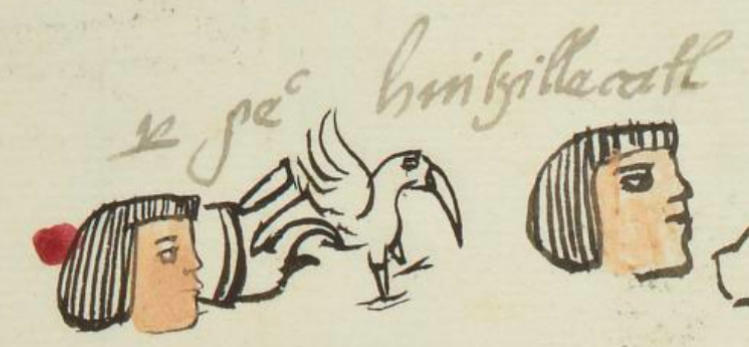Huitzilecatl (MH516r)
This black-line drawing of the simplex glyph for the personal name Huitzilecatl (here, attested as a man's name) has two prominent elements. On the right is a hummingbird (huitzilin) in profile, facing the viewer's right. On the left is the diagnostic beak from representations of the divine force of the wind (Ehecatl). The bird's wings are raised and its long beak is pointing downward. One foot is raised. If it were not for the gloss, the beak of Ehecatl could be difficult to decipher, but one can make of the squared-off protrusion and the downward curving upper beak beneath the protrusion.
Stephanie Wood
Gabrielle Vail and Christine Hernández (Re-Creating Primordial Time, 2013, ) describe Ehecatl as the wind aspect of Quetzalcoatl, and they note that Ehecatl "wears a buccal (duck) mask through which to blow wind." That the "beak" may have been perceived as a blowing device is supported by the glyph for Pitztli (below).
John Montgomery drew a group of wind glyphs (possibly mainly Mixtec), showing the variety of ways the blowing device might look. It is published in FAMSI, Inc.
A great many glyphs in this collection start with Eca- when one might expect Eheca-. We are preserving the proclivity of the gloss for Eca-, while also pointing to the likelihood of an unintentional oral abbreviation of Eheca- to Eca-.
Stephanie Wood
peo huitzillecatl
Pedro Huitzilecatl (o Huitzilehecatl)
Stephanie Wood
1560
Jeff Haskett-Wood
birds, deidades, deities, wind, viento, colibríes, nombres de hombres, ave, aves, pájaro, pájaros, pluma, plumas, animals, animales

huitzil(in), hummingbird, https://nahuatl.wired-humanities.org/content/huitzilin
eca(tl), air, breath, https://nahuatl.wired-humanities.org/content/ecatl
eheca(tl), wind-divine force, https://nahuatl.wired-humanities.org/content/ehecatl
El Colibrí y La Deidad del Viento
Matrícula de Huexotzinco, folio 516r, World Digital Library, https://www.loc.gov/resource/gdcwdl.wdl_15282/?sp=111&st=image
This manuscript is hosted by the Library of Congress and the World Digital Library; used here with the Creative Commons, “Attribution-NonCommercial-ShareAlike 3.0 License” (CC-BY-NC-SAq 3.0).






